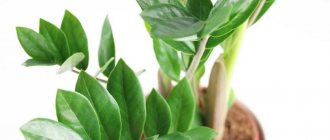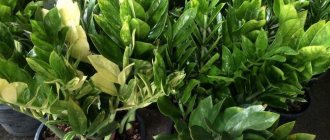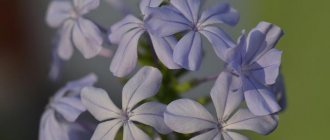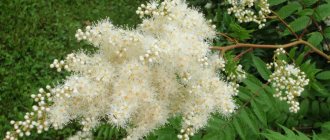Plants » Flowers
0
501
Article rating
Kira Stoletova
Zamioculcas Zenzi dwarf is an artificially bred variety with shortened petioles. This houseplant is native to tropical Africa. This exotic beauty has brutal power and remarkable endurance. It went on sale in the late 90s, but has won many fans among flower growers and designers.
Zamioculcas zenzi photo
Detailed description and photo
Zamioculcas Zenzi (Zamioculcas cv Zenzi) is a dwarf form of Zamioculcas , it grows up to 60-75 cm. The evergreen plant has a compact shape and pronounced colors.
At first glance, you might mistake this succulent for an artificial one. In addition, this flower has the amazing feature of hiding its miniature trunk in the ground. Instead of a stem, a small tuber is formed, where moisture reserves are accumulated. The tuber looks like a dark brown potato.
This is interesting. What is mistaken for a trunk is actually a leaf with individual leaf-like blades.
With good care it blooms, but very rarely . Most often, lovers are content with beautiful green leaves.
Trimming
Pruning is not a prerequisite for proper plant care. It is carried out only to give it a certain shape or rejuvenation. You can trim any part of the plant: tuber, leaves, cuttings. The main thing is that the pruning tool is very sharp and sterile. A scalpel, garden pruning shears, and a sharp knife will do.
Also read: Choosing succulents for planting in the ground in the garden
The cut area must be sprinkled with crushed activated carbon. This will quickly stop the leakage and block access to the “wound” for pathogenic microorganisms. Often pruning is used to treat the currency tree.
Bloom
Zamioculcas Zenzi blooms with inflorescences; they consist of a spadix and a spathe, which appear at the very base of the leaves. The spadix is an inflorescence consisting of small flowers of light shades: milky, light cream or yellowish, which smell quite pleasant.
The flowers are heterosexual and are found in inflorescences separately from each other. Women's - from below, men's - from above. Between them there are sterile flowers, they create a zone of sterility. Its role is to prevent plants from self-pollinating.
When and how does it bloom?
The flowering period occurs in spring . First, a small peduncle is thrown out, and a light leaf appears from it, covering the inflorescence. The Zenzi flower itself is inconspicuous.
The blanket has the same color as the rest of the leaf blades. For this reason, the inflorescence is difficult to see. The cob is first directed upwards, a little later, as it ripens, the cob begins to lean toward the ground.
What do the fruits look like?
The inflorescence itself is inconspicuous; it is formed on a small fleshy stem.
Zenzi blooms rarely, and fruits appear even more rarely in the form of small brown berries, and the seeds practically never ripen completely .
Zamiokulkas at home
Thanks to its exceptional tolerance to low light levels, Zamioculcas can even be used as a houseplant without any problems! Recommended for all rooms, especially shaded bedrooms, staircases and corridors. Because the plant is slow growing, it is easy to incorporate into an arrangement and looks great in the company of other tropical plants, especially palms, ficus, monstera or sansevieria.
In addition to its decorative qualities, zamioculcas is also capable of purifying indoor air. According to a study published in 2014 by scientists from the University of Copenhagen, it removes dangerous volatile compounds such as toluene, benzene, ethylbenzene and xylene from the environment.
How much does an adult plant cost, where can I buy it?
Mature, mature plants can be purchased subject to availability and on order in flower shops. Good deals can be found in online stores.
In the Miltonia store, serving Moscow and the Moscow region, depending on the height of the leaves, prices are distributed as follows :
- 1550 rubles for a plant 50 cm high.
- A 60-centimeter flower costs 2880 rubles.
- It is possible to order delivery of plants with a height of 75 cm.
Hobbyists distribute Zenzi through social networks and sell it on online platforms.
Landing
Most often, the plant is grown from seeds or tubers with a pair of shoots.
Choosing a pot
Choose a tall pot, 3-5 cm larger than the tuber. In such a pot there will be room for both the stem and the roots.
- Young plants are planted in clay pots, they are replanted every year, and there is no danger of damaging the stem.
- Adult plants are transplanted as the underground part grows, which, as it develops, can fill the entire pot and even deform its walls. It is convenient to plant adult Zenzi in flexible pots, which can be cut painlessly for the plant and remove the tuber without damaging it. For beauty, such pots can be placed in flowerpots.
What should the soil be like?
Since Zamioculcus is a succulent, a suitable planting substrate for cacti . If you collect the soil mixture yourself, then the proportions are as follows: equal parts of leaf soil, peat, sand and turf soil. You need to add small pebbles and coal to the mixture.
How to plant?
- Place drainage made of expanded clay or small pebbles at the bottom of the new pot so that it occupies a quarter of the container.
- Add soil mixture.
- Place the tubers in the center of the pot.
- Add mixture.
- Do not water.
- Make the first watering after 5-7 days.
Reproduction methods
It is better to start in the spring, when the chance of a new shoot taking root increases significantly. Only a healthy flower, without damage or disease (especially fungal ones), is suitable for propagation.
The procedure itself can be different and carried out in several stages.
Rooting a leaf
This is the easiest way to reproduce.
You can separate any leaf from the long “feather”, cut it at an angle of 40-45° and put it in a dark place to dry for 2-3 days. The sections are sprinkled with activated carbon.
Before planting, treat the leaf with Kornevin solution.
Place the leaf in a pot of soil prepared in advance, deepening it 1/3 of the container. Cover with a glass or film on top to create a greenhouse effect.
Condensation from the walls must be wiped off regularly, and the “greenhouse” must be ventilated. In a month the leaf will take root, and after 2-3 months young shoots will appear next to it.
Cuttings
Daughter tubers, the so-called “babies,” appear periodically.
The leaf before planting can be treated with Kornevin
The leaf along with the tuber is separated from the mother bush and treated with activated carbon. Then it must be dried for 2-3 days, as with leaf propagation.
The cutting is placed in a container with a substrate so that the tuber is completely in the ground. Don't water! Watering can begin only after a few days, but little by little. Some gardeners make a greenhouse over the cuttings, but most are inclined to believe that this is not necessary.
Dividing the bush
The fastest, but also the most risky method. Only adult zamioculcas with a powerful root system are suitable for it. The process takes place in stages:
- The plant must be completely removed from the pot, shake off the soil and divide the bush into parts so that each of them has a growing point.
- The tubers are sprinkled with coal, dried and placed in separate flowerpots.
- Each part of the bush is placed in the ground so that the tuber head protrudes slightly above the surface.
- Watering begins after a few days, and feeding is completely abandoned until the zamioculcas begins to grow. You will have to be patient, because with this method of propagation the succulent experiences severe stress and takes a long time to move away from it.
Features of plant care at home
Zenzi is easy to care for . However, for better formation of leaves, you need to turn the pot from time to time so that they are all illuminated evenly. The plant loves cleanliness, so you need to give it a shower and also wipe the leaves from dust. There is no need to spray the plant; it loves dry air.
Temperature
The plant feels great in summer at a temperature of +21-32°C, in winter +16-18°C, but not lower than +15°C - this is the critical point at which the green pet can die.
Lighting
Loves the sun, but does not tolerate direct sunlight on the leaves . It tolerates shading well, but under these conditions plant growth slows down. Should be placed on southern and south-eastern windows, providing protection from bright sun. In summer, take it out onto the loggia or into the garden.
Watering
Should be moderate. Stagnation of water and excess moisture are unacceptable. You need to water the flower generously, then pour the water out of the tray or flowerpot. The roots should not come into contact with water for a long time. The plant is watered 1-2 times a week, making sure that the top layer of soil is dry to a depth of 3 cm. In winter, less often.
Attention . You don’t have to water it for 2-3 weeks; the plant will extract accumulated reserves from the tubers. But in this case, there is a danger that the plant will begin to prepare for a period of drought.
Top dressing
During active growth, from mid-spring to September, liquid fertilizing should be applied . You need to choose among fertilizer options for cacti and succulents.
Trimming
Old branches and branches with yellow leaves that have lost their beauty should be removed regularly. Since the plant is dwarf, there is no need to pinch the growth point; the leaves will reach 60-75 cm and stop growing. But you can carry out formative pruning - remove improperly growing shoots.
Transfer
Young plants are replanted every year, then once every 3-5 years, as needed. All work should be carried out according to general rules.
Care during the flowering period
If the plant has bloomed, continue watering and fertilizing. Do not move from place to place . After flowering, remove the peduncle.
What to do if it doesn't bloom?
Provide the plant with all the necessary agrotechnical techniques, keep it in the light and wait.
Transfer
Echeveria - species: agave, Pulidonis, Black Prince, Purpuzorum, Lilacina
It is better to replant a dollar tree in the spring. But if the flower was purchased in a different season, it is better to deviate from the rule. Store-bought shipping soil does not contain substances that are necessary for the healthy development of the plant.
On a note! You cannot replant newly acquired Zamioculcas Raven. For 2 weeks, the plant should be placed in a room where there are no other flowers.
Low, wide pots with many drainage holes are suitable for Black Crow. The diameter of the container should be no more than 5 cm wider than the root system of the plant.
Procedure for replanting a plant:
- Drainage and a small amount of soil are poured into the new pot.
- The flower is carefully removed from the old container (the plastic pot can be cut) and moved to a new one.
- The nutrient mixture is poured into the unfilled space and compacted a little.
- Part of the rhizome is left above the soil surface.
This method is not suitable for sick specimens. You will have to completely clear the roots of the soil, wash and cut off the damaged areas. The same should be done when dividing large plants.
Zamioculcas has very sensitive roots
Due to the increased sensitivity of the roots of the flower, its transplantation is carried out using the transshipment method while preserving the earthen coma. After this, it is better to place the plant in a shaded, warm room, and after rooting, move it to a permanent place.
Diseases and pests affecting this dwarf species
The most common diseases are:
- Root rotting occurs from low temperatures or frequent watering, as well as from stagnant moisture. Treatment: remove rotten roots, wash the rest in fungicide or potassium permanganate. Dry before planting.
- The yellowing of leaves is a natural process. But if later the leaves do not grow back, then the reason lies in the lack of watering or fertilizing; it is possible that the plant is standing in a draft. Treatment: remove the cause.
Pests:
- Aphids - treated with Fitoverm or Aktara.
- Spider mites - the plant should be treated with insecticides.
- Scale insects - remove with a damp swab or soap solution. It is best to use insecticides.
Zamioculcas Zenzi is an unpretentious plant with beautiful bright green leaves that will decorate any interior. It will delight its owner all year round.











